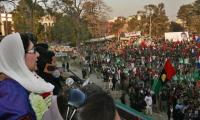Undergoing a protracted politico-economic conflict with Islamabad, Balochistan is a ticking time bomb of multiple social disasters. With immense strategic importance, abundance of natural resources, an over 700km long coastline and marine resources, the province has appalling social indicators – similar to war-torn African countries. The literacy rate in the province stands at 28 percent, much below than South Sudan (31.9 percent) and the Central African Republic (36.8 percent).
With an estimated two billion dollars worth of annual production of gas, copper-gold, zinc-lead, coal, marble and other countless minerals, Balochistan has a terribly low literacy rate, a decaying education system, high gender gap and the weakest access to education services in Pakistan.
The education emergency has never been a priority of both the central and provincial governments. The central government prefers to meddle in political affairs, co-opting and empowering the shady elite – including loads of so-called ‘sardars’. This has resulted in the destruction of the future of millions of citizens as well as national institutions.
Islamabad looks at Balochistan with a fixed mindset and narrow perspective; and has tried to achieve long-term means at the cost of backwardness and a bleak future for millions of children in Balochistan.
Systematic oppression, bad governance, corruption, mismanagement of natural resource revenue etc have created a black hole of social crisis; education is one of these social emergencies.
The children of the province – which struggle to survive early age diseases, malnutrition and stunting – face the challenge of limited access to decent and quality education. Balochistan is home to the highest proportion of out-of-school children. Out of 2.2 million, 1.8 million children are out of school and without access to any kind of education.
‘Education Statistics 2014-2015’, launched by the Academy of Educational Planning and Management, estimated that 24.02 million children between the ages of 5 and 16 were out of school in Pakistan, and Balochistan had the highest percentage – 70 percent – of out-of-school children.
Though rarely highlighted or even acknowledged by the centre, secondary school enrolment rates in Balochistan are about a third lower than the figures of Punjab. There are a total of 12,347 state-run schools in Balochistan, of which merely six percent are high schools. Only 50,000 students appear for the matriculation examination every year. That is a matter of grave concern.
To be effective in the long run, improvements in education need to enable all students to have access to quality education without disparity, to stay in the system until at least the end of upper secondary education, and to obtain the skills and knowledge they will need for effective social and labour market integration.
Access, equity and quality of education are very important considerations while analysing the effectiveness of an education system. For each of these important parameters, there are a number of indicators which can determine the level of access, equity and quality.
To further understand why Balochistan has a bleak education landscape we have to understand some basics of education planning. That includes in-depth and comparative knowledge of net enrolment ratio, intake rate, pupil-classroom ratio and pupil-teacher ratio.
Pupil-teacher ratio (PTR) is one of the key indicators used in long-term educational planning and resource allocation towards the education sector.
According to the Education Statistics 2015-16 report, at the pre-primary level Balochistan has a frightening pupil-teacher ratio, 42 compare to 13 and 20 in Punjab and Sindh respectively. A high PTR suggests that each teacher has to deal with a large number of pupils and that, conversely, pupils receive less attention from the teacher.
Along with the systematic negligence and step-motherly treatment by Islamabad, Balochistan has also not been the ‘most favoured’ province for international donors. This is partially due to the state’s policy of total alienation and blackout, creating a facade of insecurity and encouraging donors to remain active close to Islamabad.
In June 2015, the interior minister had ordered to shut down Save the Children’s operations in Balochistan and Khyber Pakhtunkhwa. Reacting on Ch Nisar’s policy, Balochistan’s health minister had condemned the closure of Save the Children’s operations in the province, terming it a ‘conspiracy’ to keep the region backward. He also alleged that the funds that were supposed to be spent on the education sector of Balochistan and Khyber Pakhtunkhwa through Save the Children had been transferred to Punjab and Sindh.
Lack of donor interest and lack of improvement in the province’s education sector is mainly due to Islamabad’s blue-eyed class of ‘politicians’ and ‘bureaucrats’ who lacks the required national and local vision to uplift Balochistan from the clutches of poverty, illiteracy, unemployment and quagmire of corruption. The centre-appointed chief secretaries are to be largely blamed for their lukewarm actions and interest in the province’s critical social and economic matters.
In addition, a special breed of bureaucracy in Balochistan, seated in the secretariat, has been trained to copy-paste bulky documents without an inclusive process of planning and budget-making. There hasn’t been a single district level consultation meeting on budget-making, prioritisation of projects and funds allocation. All these steps take place in drawing rooms, using decade old budget templates and bargaining with ministers to ensure the inclusion of projects that can be easily turned into cash.
Balochistan has a total of 13,000 government-run schools out of which 5,000 have only a single teacher and a single shelter – a locally built mud shelter with no water, electricity, stationary, desks, chairs or other facilities like toilet and playgrounds.
Balochistan cannot turn into a peaceful haven if every day countless children leave their homes with no future or any access to a place where their tender minds are turned productive and useful.
Balochistan’s insecurity will continue to increase with each passing day. It can only be reversed through sober thinking and wise policies in which national security is linked with human development and human security. Violence has caused pain and suffering on both sides. As a result, Balochistan is sliding backward. It needs a combined political and social strategy along with true leadership so that it doesn’t slide completely into a quagmire.
When children are deprived of education and youth are denied opportunities, this frustration and lack of opportunities and options boils over into violence and crime.
The writer is a former senator from Balochistan.
Email: balochbnp@gmail.com
When she left venue after addressing rally, large of people came out onto streets to catch glimpse of their great...
Anniversary of her death is not just moment to mourn but time to reflect on what Pakistan lost
This production could reduce carbon emissions by 70-80 per cent compared to conventional jet fuels
She chose to give her life, leaving behind legacy of incredible struggle for democracy
A Pakistani man rests under the shade of trees during a heatwave in Karachi, Pakistan, on June 23, 2015. — AFP The...
Ms Benazir Bhutto had returned to Pakistan with mission of reconciliation in politically and religiously divided country







